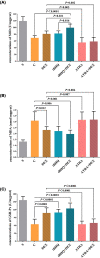Role of Keap1-Nrf2/ARE signal transduction pathway in protection of dexmedetomidine preconditioning against myocardial ischemia/reperfusion injury
- PMID: 35959640
- PMCID: PMC9446386
- DOI: 10.1042/BSR20221306
Role of Keap1-Nrf2/ARE signal transduction pathway in protection of dexmedetomidine preconditioning against myocardial ischemia/reperfusion injury
Abstract
Objective: To explore the role and mechanism of the Kelch sample related protein-1-nuclear factor erythroid-2 related factor 2/antioxidant response element (Keap1-Nrf2/ARE) signaling pathway in protection of dexmedetomidine (DEX) preconditioning against myocardial ischemia/reperfusion injury (MIRI).
Methods: A total of 70 male SD rats were randomly divided into seven equal groups (n=10): blank control (S group), ischemia/reperfusion injury (C group), DEX preconditioning (DEX group), tertiary butylhydroquinone (tBHQ) control (tBHQ group), combined tBHQ and DEX preconditioning (tBHQ+DEX group), all-trans retinoic acid (ATRA) control (ATRA group), and combined ATRA and DEX preconditioning (ATRA+DEX group). Serum creatine kinase-MB (CK-MB) and cardiac troponin I (cTnI) concentrations were measured by ELISA kits, and the infarct size (IS) was assessed by Evan's blue and 2,3,5-triphenyltetrazolium chloride (TTC) staining. Oxidative stress was assessed through Western blotting for expression of Keap1-Nrf2/ARE pathway members and oxidative stress markers.
Results: Cardioprotection of DEX, tBHQ, and tBHQ+DEX preconditioning treatments were shown as lower concentrations of serum CK-MB and cTnI and a smaller IS following MIRI in rats compared with those of MIRI rats without pre-treatment. In addition, tBHQ+DEX preconditioning exhibited stronger myocardial protection compared with DEX preconditioning. Mechanistically, the cardioprotection offered by DEX, tBHQ, and tBHQ+DEX preconditioning treatments was mediated via exerting antioxidant stress through activation of the Keap1-Nrf2/ARE signal transduction pathway. Conversely, the protective effects of DEX were diminished by blocking the Keap1-Nrf2/ARE pathway with inhibitor ATRA.
Conclusion: DEX preconditioning protects against MIRI by exerting antioxidant stress through activation of the Keap1-Nrf2/ARE signal transduction pathway, while inhibition of the Keap1-Nrf2/ARE signal transduction pathway reverses the protective effect of DEX preconditioning on MIRI.
Keywords: Dexmedetomidine; Keap1-Nrf2/ARE signal transduction pathway; Myocardial ischemia/reperfusion injury; Oxidative stress.
© 2022 The Author(s).
Conflict of interest statement
The authors declare that there are no competing interests associated with the manuscript.
Figures



 , n=5.
, n=5.
 , n=5.
, n=5.
 , n=5.
, n=5.Similar articles
-
Pretreatment with Panaxatriol Saponin Attenuates Mitochondrial Apoptosis and Oxidative Stress to Facilitate Treatment of Myocardial Ischemia-Reperfusion Injury via the Regulation of Keap1/Nrf2 Activity.Oxid Med Cell Longev. 2022 May 27;2022:9626703. doi: 10.1155/2022/9626703. eCollection 2022. Oxid Med Cell Longev. 2022. PMID: 35669855 Free PMC article.
-
Bombesin protects myocardium against ischemia/reperfusion injury via activation of the Keap1-Nrf2-HO-1 signaling pathway.Peptides. 2024 Oct;180:171279. doi: 10.1016/j.peptides.2024.171279. Epub 2024 Jul 23. Peptides. 2024. PMID: 39053647
-
hUC-MSC-EV-miR-24 enhances the protective effect of dexmedetomidine preconditioning against myocardial ischemia-reperfusion injury through the KEAP1/Nrf2/HO-1 signaling.Drug Deliv Transl Res. 2024 Jan;14(1):143-157. doi: 10.1007/s13346-023-01388-7. Epub 2023 Aug 4. Drug Deliv Transl Res. 2024. PMID: 37540334
-
Involvement of Nrf2 in myocardial ischemia and reperfusion injury.Int J Biol Macromol. 2019 Mar 15;125:496-502. doi: 10.1016/j.ijbiomac.2018.11.190. Epub 2018 Nov 20. Int J Biol Macromol. 2019. PMID: 30468811 Review.
-
Arsenic-mediated activation of the Nrf2-Keap1 antioxidant pathway.J Biochem Mol Toxicol. 2013 Feb;27(2):99-105. doi: 10.1002/jbt.21463. Epub 2012 Nov 27. J Biochem Mol Toxicol. 2013. PMID: 23188707 Free PMC article. Review.
Cited by
-
Cardioprotective Effects of Dexmedetomidine in an Oxidative-Stress In Vitro Model of Neonatal Rat Cardiomyocytes.Antioxidants (Basel). 2023 Jun 2;12(6):1206. doi: 10.3390/antiox12061206. Antioxidants (Basel). 2023. PMID: 37371938 Free PMC article.
-
LAR Downregulation Protects the Astrocytic U251 and Cocultured SH-SY5Y Cells in a Rotenone-Induced Parkinson's Disease Cell Model.Int J Mol Sci. 2023 Jul 5;24(13):11111. doi: 10.3390/ijms241311111. Int J Mol Sci. 2023. PMID: 37446291 Free PMC article.
-
Sirtuin 3 is required for the dexmedetomidine-mediated alleviation of inflammation and oxidative stress in nephritis.Immun Inflamm Dis. 2024 Jan;12(1):e1135. doi: 10.1002/iid3.1135. Immun Inflamm Dis. 2024. PMID: 38270316 Free PMC article.
-
The Value of Electroacupuncture in the Treatment of Coronary Heart Disease: A Review of the Mechanisms and Clinical Studies of Electroacupuncture Therapy.Cardiol Res Pract. 2025 Jul 1;2025:4684871. doi: 10.1155/crp/4684871. eCollection 2025. Cardiol Res Pract. 2025. PMID: 40654523 Free PMC article. Review.
-
Tertiary butylhydroquinone regulates oxidative stress in spleen injury induced by gas explosion via the Nrf2/HO-1 signaling pathway.Sci Rep. 2025 Apr 8;15(1):11987. doi: 10.1038/s41598-025-97096-y. Sci Rep. 2025. PMID: 40200066 Free PMC article.
References
MeSH terms
Substances
LinkOut - more resources
Full Text Sources
Research Materials
Miscellaneous

